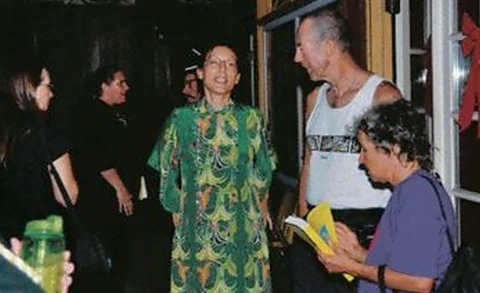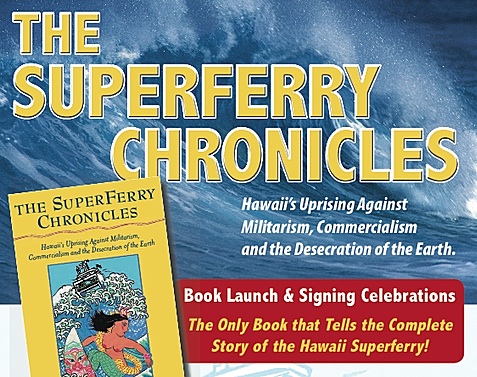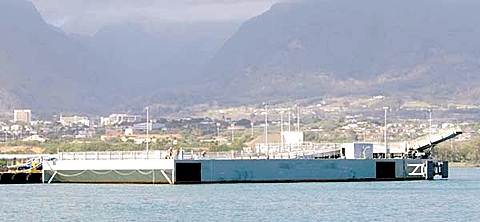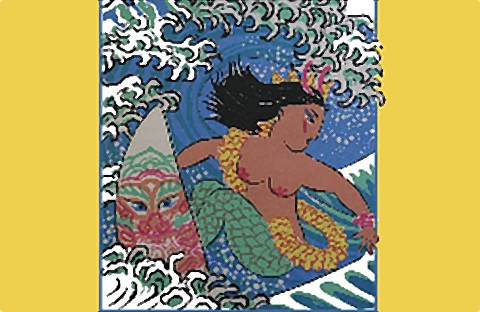by Brad Parsons on 4 December 2008 in hisuperferry.blogspot.com
The overall sense I get from the book is that all of Hawaii and specific islands like Kauai and Maui by their centuries of history and culture have world class potential that is dependent upon the aina and akamai decisions by the people and that residents and political leaders should not prematurely sell themselves short with fake, unsustainable decisions and projects.
The book is in three parts. I'm going to review each part. But, first, I should say why the review.
I just sat in on a radio interview that got way off topic in which I mostly just listened. In fact, I was cut off when I tried to make a good point about the book, one of only two brief comments I made during the entire interview. More importantly, though, I have not heard an interview yet that gets into the really good content of this book, much less some of the most useful points that the testimonial content of this book makes. I'm not going to
mention publicly any of the minor misquotes and weaknesses in this book. Instead, I'm going to point out some of the great points made by testifiers and the authors of this book.
I'm going to mention these quotes in order as there are so many good ones.
From page 45 is the following quote, "The Superferry itself was not the most egregious example of commercial or military excess, but it came after decades of frustration and humiliation, as the people saw their island steadily diminish in character and mood..."
From page 51 is the following line of thought, "The Superferry fits perfectly into Oahu's economic paradigm of expanding markets and global connectivity, at the unfortunate expense of environmental health and indigenous culture...[Oahu] an economy dependent on growth, versus...sustainability."
From page 52-53, "Longing for Hanabata Days...Oahuans...want to have the option of stepping back to simpler days through a handy three-hour boat ride to charming outer islands, which still have the qualities they gave up....Karen Chun has this insightful explanation...Oahu's so changed now, so urban. People there have a real longing for hanabata days. They view the outer islands as a bit of their lost past...It is such an emotional thing, it's
about their lost past."
From page 54, "...what happens in Hawaii [spiritually] affects the rest of the world...Liko Martin...elaborates...'If Hawaii stays oppressed,' he points out, 'that oppression emanates throughout the whole planet. If Hawaii is free, then aloha spreads out over the Earth. Because it's [Hawaii's] the piko.'" [The navel--the center of the Pacific]
The testimonies from Kauai to the Governor on Sept. 20, 2007, were all outstanding, but the following stood out to me upon reading them. Some of them did not show up in the video footage that I had seen.
From pages 65-66, Kauai's Lloyd Imuaikaika Pratt's testimony to the Governor was outstanding and should be read in it's entirety.
From pages 72-73, Kauai's Pua La'a Norwood's testimony to the Governor was outstanding and should be read in it's entirety. Pua La'a would like for her quote to have included her comments on solar and wind. Some believe those comments actually changed policy on Kauai beyond just the Superferry.
From pages 84-85, Kauai's Raymond Catania's testimony to the Governor was outstanding and should be read in it's entirety.
The diary entry about the events of August 27, 2007, from Michael Shooltz starting on page 92 is outstanding, I mean OUTSTANDING. His story about the friendly interaction with the police officer before the protest started is quite interesting.
Later, the following quote is particularly insightful:
" Being in the water was a beautiful experience. The full moon rising was magnificent. I gave chunks of the...bars to many of those who had already been in the water for a couple of hours. They were received with laughter, joy, and appreciation. It was fun, kind of a boogie board 'special delivery.' The next hours floating in the water were filled with quiet conversations as folks got to know one another and expressed appreciation. I learned from
a farmer from Moloa'a about how the lettuce and broccoli are doing. Other bright young kids spoke of their concerns for the whales and dolphins...As we were spread out across the harbor, there was one beautiful young woman on a board whom I only know by her voice as she would periodically lead us all in Hawaiian chants. [Mehana?] The mana of the chants was strong, there on the water, under the full moon."
Michael Shooltz continued on page 96, "I wish I could do a search on this computer that would reveal the thoughts and feelings of each stalwart in the water as we watched the lights of the Superferry disappear over the horizon under the full moon." Yes, Michael, I have been looking for something like that too.
The Maui testimonies before the PUC on Nov. 17, 2004, are all good, but the one that really got my attention is the realistic optimistic vision of Iokepa Naeole of the powerhouse Hawaiian Canoe Club:
" I just want to share with you my plans. I don't think you've taken time to listen to what we have planned for Kahului Harbor. In 2020, we will have tripled our fleet of canoes between Na Kai 'Ewalu and Hawaiian Canoe Club. We will have gone from 300 members to 1,000 members in 2020. In 2020, any given day of the week, Monday through Friday, you will see Kahului Harbor filled with canoes--one-man, two-man, three-man, and six-man--because people decided
to go paddle instead of eat their Happy Meal.
In 2020, Kahului Harbor will look like Papeete, full of healthy people practicing their culture on the ocean and staying healthy. In 2020, the ice problem will have been eliminated, because all of those kids that we do have now paddling will spread the word on to their friends so they will all become part of our paddling, surfing, fishing community, recreational users, cultural users of the
harbor, and ice will be a thing of the past...And I'm not talking dakine Feast at Lele, you know, hula show, I'm talking living, breathing culture...that in the future it will be something that you will never see anywhere else on the planet. In 2020, the typical visitor will go home knowing that Hawaii is the number one place to visit not because of the infrastructure provided for the visitor industry, but because of the people that are here
and the way we
feel about how to live on this planet [sustainably]. With aloha."
The author's did not make use of the Kauai testimonies to the Senators who visited Kauai and the other outer islands in October 2007. Some of that video should go up on the Internet. The author's also did not use testimonies at the Capitol from October 2007. Some of those were especially good and show what the Legislature did not consider for inclusion in Act 2. In particular, the testimony by Kawika Winter, Director of Limahuli Garden and Preserve,
delivered impromptu at the Capitol completely in the Hawaiian language was particularly impressive.
From the book, I especially liked Keone Kealoha's, Rick White's, and David Dinner's transcribed testimonies to Belt Collins on Kauai on March 19, 2008.
The local testimonies on March 11, 2008, given by Molokai residents to Belt Collins stand out as particularly poignant:
On page 123, Judy Caparida asks and states, [on Molokai] "...does it really matter to our life? [The Superferry] is something that people want to make for us so that we live by the way they want us to live. We're so free because we're contented.
We love what we have. We don't need to have all the stuff over there...What God has given us is free!...You work...For what? Taxes here, taxes there...We don't want the Superferry here, because we don't
need 'em...[to Belt Collins] Make sure you guys get down to life--not fantasy, not make-believe...[We] want to live the simple and free Life."
On page 124, Laurie Buchanan states, "...We've seen all the beautiful commercials with Molokai as a backdrop. We try to keep it that way for a reason. It's not to be exploited by commercials or by the Superferry."
Part 2 of this review will be on the second third of the book, the timeline of events on the issue.
My overall sense from these testimonies, esp. from that of people like Iokepa Naeole is that all of Hawaii and specific islands like Kauai and Maui by their centuries of history and culture have world class potential that is dependent upon the aina and akamai decisions by the people and that residents and political leaders should not prematurely sell themselves short with fake, unsustainable decisions and projects. Hawaii has limitless potential
in this world and this is the positive lesson that should be learned from this issue.
These are the things that need to be said on the radio.
Gathering ignites a dialog
by Nathan Eagle on 5 December 2008 in The Garden Island
Protesters meet protesters at ‘Superferry Chronicles’ book launch in Hanapepe. After playing a veiled game of cat and mouse, a pro-Hawaii Superferry rally on Wednesday greeted residents critical of the inter-island catamaran as they entered the Storybook Theatre in Hanapepe for the launch of a book on the beleaguered company.
The latter group arrived to hear co-authors Koohan Paik and Jerry Mander talk about “The Superferry Chronicles: Hawaii’s Uprising Against Militarism, Commercialism, and the Desecration of the Earth” (Koa Books).
The evening discussion — which included remarks from local fishermen, a state biologist and political activists — marked the pair’s first of three such events this week on Kaua‘i. But it was the sidewalk dialog prior to the book launch party that told the story of where this island may stand on an issue that has divided it since last year.
The two sides did not clash when they met outside the mostly closed stores along Hanapepe Road. Voices at times grew on edge as the sun set behind the historic town, but it remained a respectful exchange of viewpoints.
That there was a dialog, as opposed to the reported stone-throwing or hurling of insults at previous rallies, may reflect the healing power of time.
Fifteen months have passed since some 1,500 protesters lined the jetty road and clogged the harbor, forcing the 850-foot “Alakai” to return to Honolulu without unloading its passengers and vehicles on its second voyage to the Garden Isle. Paik and Mander refer to it in their book as “The Incident at Nawiliwili.”
A pro-Superferry crowd of some 15 residents rallied an hour before the book launch party was set to start. They waved signs saying “Save Superferry” and “Yes to Choice” and encouraged drivers passing by to honk their horns in support. Several did. Others shouted out the window, “Go to Maui.”
Kapa‘a resident Kimo Rosen has led the pro-Superferry cry. This was his most successful rally to date.
“
The first time I did it I was alone,” he said.
A growing number of community members have joined his cause for different reasons. Some said they want the Superferry because an alternative form of transportation is needed. Others said they support the company because they were turned off by the actions of some of the protesters last year. Some said the ship would help local businesses and unite families and friends.
A few of the nearly three dozen residents who turned out for the book launch party engaged their opposition before heading inside the cozy theatre. They seemed to mystify the pro-Superferry crowd with an onslaught of questions to stimulate critical thinking.
Uncomfortable smiles accompanied literal backpedaling when a broad swath of common ground was revealed.
Some of the residents who protested at Nawiliwili underscored that they are against this company’s practices, such as its operating speeds, and the blow Gov. Linda Lingle’s administration dealt the democratic process when environmental laws were trumped to help a Mainland business come to Hawai‘i.
As Paik said in reference to a section in her book, “We love ferries.”
She called it a “false vision” to say “we’re not for alternative transportation or the economy.”
“
We’re for an economy of sustainability,” Paik said, noting the state’s dependence on its natural resources to support tourism.
Eastside resident Jonathan Jay, who has been active in the Superferry debacle for more than a year, took a seeker-of-information approach. He asked the rally participants why they wanted the Superferry to resume service to Kaua‘i, which has been on hold since the Nawiliwili incident.
At times, he had difficulty getting a word in edgewise. At other times, he was cast into a “them” pile of “disrespectful protesters” despite never stating his position on the issue.
Jay was curtly denied when he asked an electrical engineer if he could give him his e-mail address to exchange information about more fuel-efficient ferries, such as sail-supported vessels.
If someone changed their position, it was not articulated then. Nonetheless, a dialog ensued.
Puhi resident Rachel Forer was on the Alakai with her husband when it made its inaugural trip to Kaua‘i. She said they were more against the Superferry at that point than for it and took advantage of the deeply discounted $5 fares to check it out.
When the boat pulled into Nawiliwili Harbor the evening of Aug. 26, 2007, Forer said they were greeted with profanity amid the chants and drums.
“
I switched over that day,” she said. “We’re from like the ‘60s, dude, so I’m all for people protesting but you’ve got to respect different opinions. There are people who are afraid to say they’re for the Superferry for fear of messing up their contacts. That’s so un-American.”
Jennifer and Dave Houle of Kalaheo agreed.
“
I don’t like to be dictated to by intimidation,” he said.
For others, it was more about the economic benefit and the unfairness of singling out a business.
“
It’s a joke being an island community and not having a ferry,” Rosen said. “If it’s going to be successful, it’ll prove itself in a matter of time.”
He said while rocks have been hurled at him, it was not by the anti-Superferry folks gathered Wednesday evening. Rosen said Jay and community organizers such as Wailua resident Rich Hoeppner welcomed him at their recent celebration of the Nawiliwili protests.
Still, Jennifer Houle said the opposition has not been straightforward. For example, she said there have been no incidents of the catamaran hitting whales.
The Superferry has been running its daily O‘ahu-Maui route, with some weather- and mechanical-related stops, since the state untethered it last October. The company has not set a timetable to resume service to Kaua‘i.
Legal barriers were removed after the Legislature passed a law in a special session effectively overturning a state Supreme Court decision saying an environmental impact statement should have been required before the company began service.
An environmental assessment is underway as mandated by Act 2, but this has been criticized as an insufficient study that fails to follow the environmental law laid out in Chapter 343.
“
What is this really about?” Houle said.
Paik and Mander’s book expounds on an alleged military link to the Superferry.
He pointed at Superferry board member John Lehman, a military financier and former Navy secretary.
“
This is not a local business that cares about local people,” Mander said, noting the company is based in New York.
The book’s Web site links to a Nov. 13 Press-Register article about Alabama-based Austal winning a $1.6 billion Navy contract to build up to 10 high-speed transports like the two the shipyard built for the Superferry.
Mander said the Alakai may be a prototype and this is really about a military build-up for war against China. The author is director of the International Forum on Globalization, a San Francisco “think tank” focused since 1994 on exposing the negative impacts of economic globalization.
But for all the criticism of Lehman, the authors heaped more blame on Lingle.
“
The Superferry was used as a stepping stone in her career at the expense of her constituency,” Mander said.
He called the protesters his heroes and said as a Mainlander he is trying to spread the word of their victories.
“
The Superferry may not be the worst thing ... but it’s the latest and maybe the most arrogant and self-serving,” Mander said.
Paik is a journalist, media-literacy educator and award-winning filmmaker based on Kaua‘i. Her work focuses on preservation of culture and language.
“
We’re simply defending our land ... our right to local sovereignty,” she said.
George Inouye, a Waimea kama‘aina and fisherman, said the community has to stick together.
“
We have to keep our resources for our family,” he said. “They can come over here and visit but go back empty cooler.”
State Department of Land and Natural Resources aquatic biologist Don Heacok said it is about a top-down government versus a community-based government.
Paik and Mander take on the Superferry subject very broadly in their book, setting the context and incorporating testimonies from several key public hearings. They also detail the history of the project as “the evolution of a boondoggle.”
The book discusses the need to limit development and fight the “long arm of absentee landowners” who remove citizens’ rights, Mander said.
A ferry in Hawai‘i sounds great, he said. But it should be run at a slower pace by a “local operator with local values.”
The authors held a similar book launch event at Borders Books and Music last night in Lihu‘e and another is set for 6 p.m., today, at Malama Kaua‘i in Kilauea.
The Hanapepe book launch party and pro-Superferry rally were originally scheduled to be at Hanapepe United Church of Christ. Paik announced the change in venue last week; Rosen quickly followed suit.
When car horns briefly interrupted Paik’s reading at Storybook Theatre, she simply said, “See you at Borders.”
As a Hanapepe resident leaving the event said, the two sides are talking.
• For more information, visit
www.superferrychronicles.com or www.hawaiisuperferry.com |



 image above: Detail of "Superferry Chronicles" cover from
image above: Detail of "Superferry Chronicles" cover from